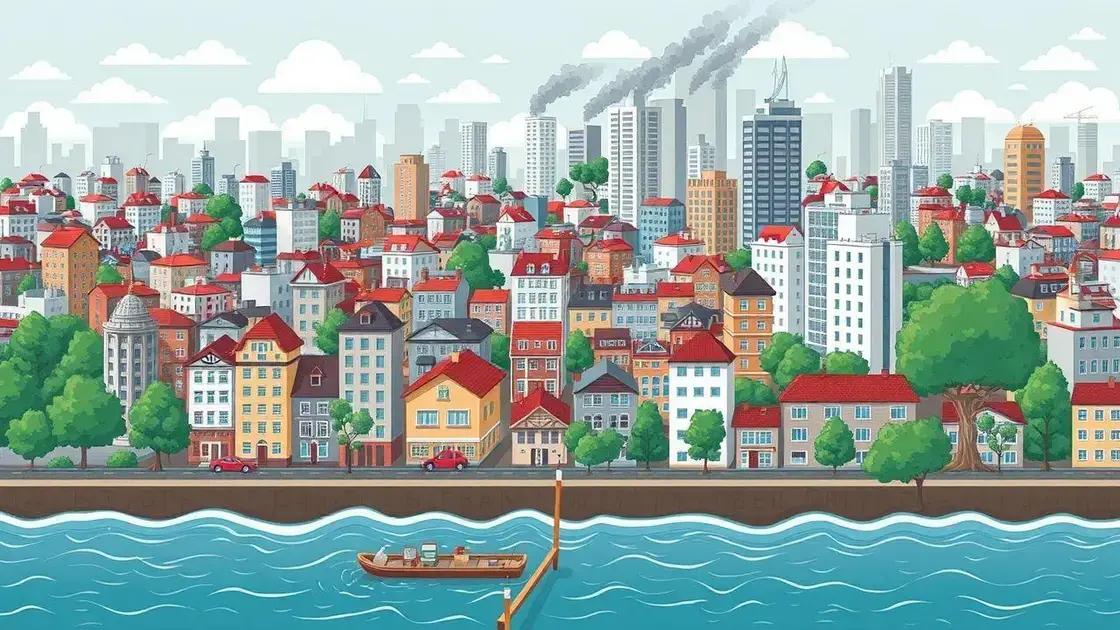Urban development news: the impact on our cities

Anúncios
Urban development news highlights critical challenges such as affordable housing shortages, traffic congestion, climate change, and the need for community engagement to create sustainable, livable cities.
Urban development news is more than just updates; it’s about how our cities evolve and adapt. Have you ever wondered how these changes impact your daily life? Let’s explore the latest trends and their significance.
Anúncios
Understanding urban development trends
Understanding urban development trends is essential for grasping how cities adapt and grow. Trends shape our urban landscapes and impact our daily lives. This section will explore some of the key elements influencing the direction of urban development.
Key Factors Defining Urban Development
Several factors are at play in determining how urban areas evolve. These factors drive decisions that affect communities and the environment. Some focal points include:
Anúncios
- The demand for affordable housing
- The effects of population growth
- Innovations in transportation
- Environmental sustainability efforts
Notably, the demand for affordable housing remains a pressing issue in many urban areas. As population increases, cities struggle to provide adequate housing options for everyone. This trend compels state and local governments to focus on building more homes, often in clusters, to maximize space.
Moreover, urban spaces are seeing increased emphasis on sustainability. From green buildings to eco-friendly public transport, city planners are committed to implementing strategies that promote a healthier environment. Technologies like smart grids and renewable energy sources also play crucial roles.
Impact of Technology on Urban Development
Technology significantly impacts urban development trends. Smart city initiatives help improve efficiency in services and resource management. For example, cities are embracing technology to streamline traffic and waste management systems. By integrating systems, cities aim to create a better quality of life for residents.
In conclusion, understanding urban development trends helps us anticipate future changes. These trends are crucial for developers, policymakers, and residents alike, shaping the communities we live in.
The role of sustainability in urban planning

The role of sustainability in urban planning is increasingly critical as cities face environmental challenges. Sustainable practices ensure that urban areas manage resources wisely while providing for current and future generations. This approach emphasizes the balance between development and ecological preservation.
Core Principles of Sustainable Urban Planning
Many principles guide sustainable urban planning. Key aspects include:
- Efficient use of land
- Integration of green spaces
- Public transport accessibility
- Energy-efficient building designs
Efficient land use promotes density without sacrificing quality of life. Integrating parks and green spaces into the urban fabric creates healthy environments. This not only benefits residents but also enhances biodiversity. Moreover, ensuring public transport accessibility can significantly reduce traffic congestion and pollution.
Energy efficiency is another major component of sustainability. Urban planners prioritize development that minimizes energy consumption. By using renewable energy sources and smart designs, cities can reduce their carbon footprints. These choices help create resilient communities that can adapt to changing climate conditions.
Community Involvement in Sustainable Practices
The community’s role is vital in promoting sustainability. Engaging residents in urban planning decisions fosters a sense of ownership. When citizens participate, they advocate for projects that reflect their needs. This partnership leads to innovative solutions and enhances the community’s overall quality of life.
Moreover, education about sustainability encourages positive behavioral changes. Communities can implement local programs that encourage recycling, conservation, and responsible land use. As awareness grows, so does the collective effort towards sustainable urban development.
Technological innovations in smart cities
Technological innovations in smart cities are transforming how urban areas function. These technologies aim to enhance the quality of life for residents while promoting sustainable growth. Understanding these innovations is key to appreciating their impact on our future.
Key Technologies Shaping Smart Cities
Several key technologies are at the forefront of the smart city movement:
- Internet of Things (IoT)
- Big Data Analytics
- Smart Grids
- Autonomous Vehicles
The Internet of Things (IoT) plays a vital role by connecting devices, allowing for seamless data sharing. This interconnectivity helps manage resources more efficiently and enhances urban services. Big data analytics enables cities to predict trends and optimize operations, ultimately enhancing decision-making.
Smart grids are another innovation that supports sustainability. These systems adjust electricity usage dynamically, reducing waste and improving energy efficiency. The integration of autonomous vehicles also contributes significantly. These vehicles can reduce traffic congestion and pollution while making transportation more accessible.
Benefits of Implementing Technology in Urban Planning
Integrating technology into urban planning leads to numerous benefits. Efficient transportation systems reduce travel time and improve access to essential services. Moreover, enhanced data collection drives better city management. Residents can experience improved public safety and maintenance through smart monitoring systems.
In addition, technology encourages community engagement. Many cities utilize mobile apps to gather resident feedback, enabling citizens to report issues directly. By fostering interactions between the government and the public, cities can create more responsive environments.
Challenges urban development faces today

Challenges urban development faces today are numerous and complex. As cities continue to grow, they encounter various issues that hinder effective planning and implementation. Understanding these challenges is essential for creating solutions that enhance urban living.
Key Challenges in Urban Development
Several significant challenges affect urban development:
- Affordable housing shortages
- Traffic congestion
- Environmental degradation
- Infrastructure strain
One major issue is the shortage of affordable housing. As populations rise, many cities struggle to provide enough housing that low- to moderate-income families can afford. This leads to overcrowded conditions and homelessness.
Traffic congestion is another persistent challenge. Growing populations increase the number of vehicles on the road, which contributes to longer commute times and higher pollution levels. As a result, cities must find innovative solutions to improve public transport and encourage alternative transportation methods.
The Impact of Climate Change
Climate change presents significant hurdles for urban areas. Rising sea levels and extreme weather events affect city planning. Urban areas must adapt their infrastructure to withstand floods, heatwaves, and other climate-related impacts.
Furthermore, environmental degradation impacts health and quality of life. Pollution and loss of green spaces can decrease urban livability. Cities are now exploring ways to integrate more green areas, enhance public parks, and promote sustainable practices to combat these issues.
Overall, addressing these challenges requires a collaborative approach from government agencies, private sectors, and the community. Only through cooperation can cities develop effective, lasting solutions that enhance quality of life.
In conclusion, urban development is shaped by various challenges, ranging from the need for affordable housing to the impacts of climate change. As cities grow, addressing these obstacles is essential for creating livable environments. By focusing on sustainable practices and embracing technological innovations, cities can enhance their infrastructure and improve the quality of life for all residents. Collaboration among community members, government, and private sectors is key to solving these urban issues. Together, we can build smarter, more resilient cities that cater to the needs of current and future generations.
FAQ – Frequently Asked Questions about Urban Development
What are the main challenges faced by urban development today?
The main challenges include affordable housing shortages, traffic congestion, climate change impacts, and infrastructure strain.
How does climate change affect urban areas?
Climate change leads to rising sea levels and extreme weather, forcing cities to adapt their infrastructure to mitigate risks.
What role does technology play in urban planning?
Technology helps create smart cities by improving resource management, enhancing public services, and encouraging community engagement.
Why is community involvement important in urban development?
Community involvement ensures that developments meet the needs of residents and fosters a sense of ownership and responsibility.






